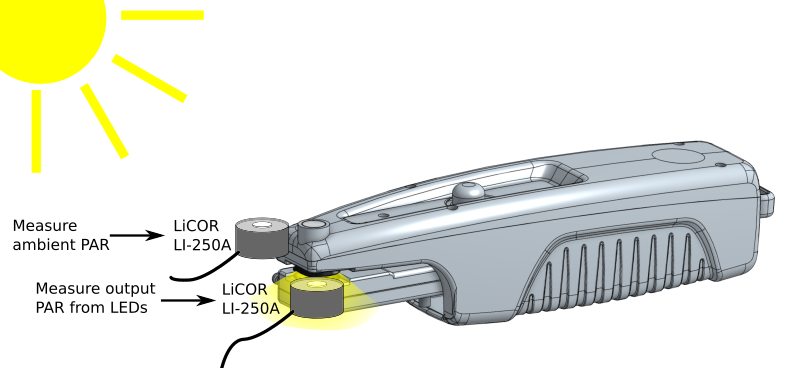Ambient PAR to LED PAR Validation
The goal of this project is to validate the conversion of ambient light intensity (PAR) to LED light produced by the MultispeQ inside the leaf chamber. The MultispeQs used were among the first 20 manufactured by Lectronics in Saline MI to be used for testing and validation.
Summary
- The MultispeQ's conversion of ambient PAR to LED light inside the leaf chamber is ActualPAR = 0.94*LEDPAR + 12.17 (r2 0.979) using 10 devices, across a range of spectral conditions and intensities, with a total of 253 measurements).
- MultispeQ LED PAR tended to be shifted higher slightly compared to the actual ambient PAR.
- Green, red, and blue LEDs (lights 1,2, and 4) correlated the best with the LiCOR LI-250A. The orange LED (light 3) performed the worst.
Background
For more background on PAR and how ambient PAR is calculated, see the PAR Confirmation project here - https://photosynq.org/projects/arrakis-par-confirmation?hl=Arrakis+%3A+PAR+confirmation.
In order to measure photosynthesis parameters (for example, Photosystem II efficiency PhiII and non-photochemical quenching PhiNPQ) the MultispeQ must be able to recreate the intensity of the ambient light inside the leaf chamber. This is a two step process - 1) measure ambient PAR, 2) convert ambient PAR into an LED intensity and turn on the LED. Below is a visual representation:

There are two points of error in this process - during the measurement of ambient PAR, and then converting that PAR to an LED intensity. This combined error will impact the quality and repeatability of photosynthesis measurements. As a result, this validation provides error values most relevant to the photosynthesis measurements.
Results
10 devices were calibrated using the projects 2a - v1.0 FACTORY CALIBRATION,2b - v1.0 FACTORY CALIBRATION,and 2c - v1.0 FACTORY CALIBRATION. These projects calibrate the ambient PAR sensor and internal visible LEDs.
To validate the calibrations, we measured ambient PAR using a LiCOR LI-250A and measured the LED output from the MultispeQ using a LiCOR LI-250A. We then compared the actual (LiCOR) ambient PAR to the PAR produced by the LEDs. See image below for details.

This was performed across a variety of spectral conditions (LED, fluorescent, outdoor cloudy, outdoor sunny), many different intensities (10.9uE to 1633uE), and 4 different LEDs in the leaf chamber (light 1 (green), light 2 (red), light 3 (orange), and light 4 (blue)), as well as across 10 devices. As a result of the amount of data, no single graph captures the results, but here is an example graph showing the red LED response across all light conditions and intensities, by device ID.

There is noticeably more variation than in the standard ambient PAR calibration, due to the compounded error described above. Here are the linear correlations to actual ambient PAR as measured by the LiCOR LI-250A for each device, and for all devices, for the red LED.
- device 1 :: y = 0.97x + 13.83 (r2 0.994)
- device 2 :: y = 0.96x + 20.92 (r2 0.987)
- device 5 :: y = 0.98x + 4.13 (r2 0.997)
- device 6 :: y = 0.88x + 29.17 (r2 0.917)
- device 8 :: y = 0.95x + -29.72 (r2 0.983)
- device 0c :: y = 0.95x + 5.25 (r2 0.998)
- device 0d :: y = 0.93x + -0.51 (r2 0.997)
- device 11 :: y = 0.88x + 19.17 (r2 0.995)
- device 15 :: y = 0.93x + 37.07 (r2 0.964)
- device 16 :: y = 1.02x + 14.9 (r2 0.999)
- all devices :: y = 0.94x + 12.17 (r2 0.979)
For any given device (with 2 exceptions - device 6 and 15) the r2 is very high, indicating that while the values will shift between devices, repeatability within a single device is fairly high. This holds true for all of the LEDs.
In order to describe the results for all LEDs, below is a table showing the average and standard deviations for each LED inside a given intensity range (0-50, 50-100, 100-500, 500-1000, 1000-2000 uE).

Note that a 95% confidence interval is 3 standard deviations.
All LEDs showed similar levels of error at low light intensities (standard deviation of 15 - 20 uE). They were all also shifted higher than the ambient PAR. However, the orange LED showed much higher error at high light intensities as compared to any other color. This is due to the specific doping required to produce orange light in an LED, which causes the light output to droop significantly at higher light intensities. Users should avoid orange when matching ambient PAR, especially at high light intensities, and focus on red, green, and blue instead.
Other sources of error
A wider range of spectral conditions, specifically incandescent and under canopy, should be included to validate the MultispeQ in more real-world conditions.